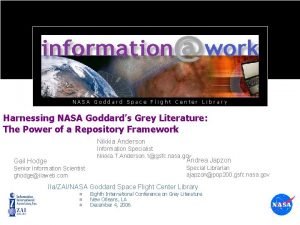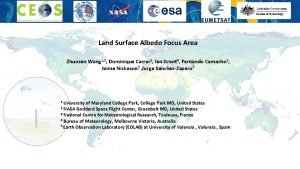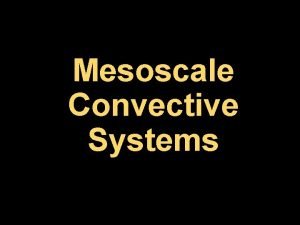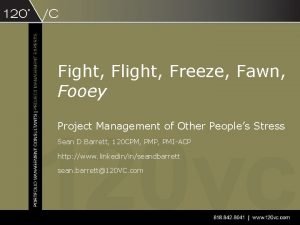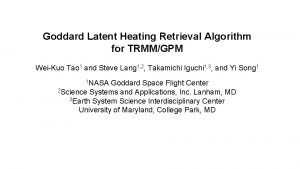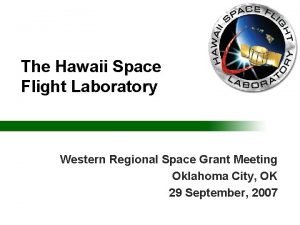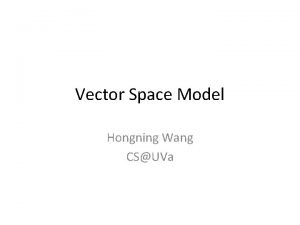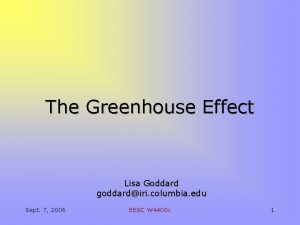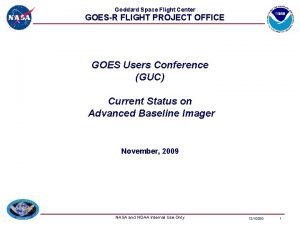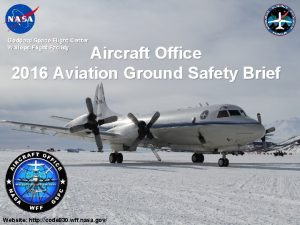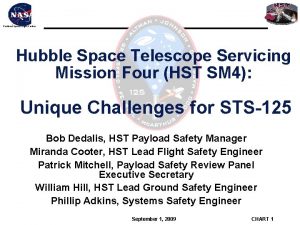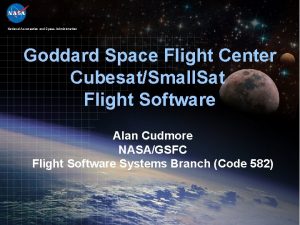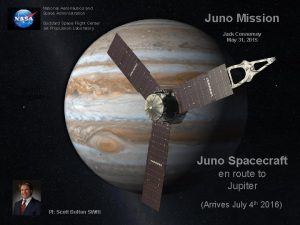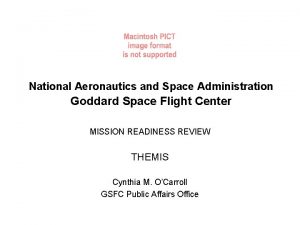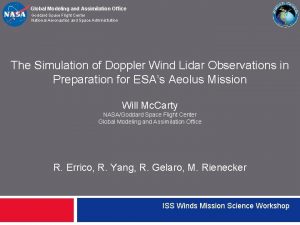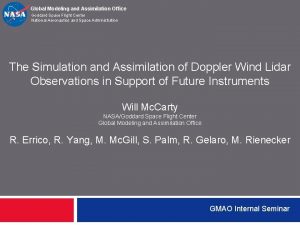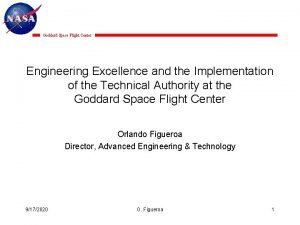Goddard Space Flight Center Mesoscale Dynamics and Modeling












- Slides: 12

Goddard Space Flight Center Mesoscale Dynamics and Modeling Group Implementation of the Updated Goddard Longwave and Shortwave Radiation Packages in WRF Toshi Matsui, Wei-Kuo Tao, and Roger Shi representing Goddard Mesoscale Dynamics and Modeling (GMDM) Group

Role of Goddard Radiation in WRF Dynamic Core Roger Shi Diabatic Heating (d. T/dt) Goddard Land Information System Land-aerosol interactions Surface emission and albedo Goddard Chemistry and Aerosol Radiation Transport (GOCART) Aerosol direct effect Goddard Radiation Land-atmosphere interactions Cloud radiative forcing Goddard Microphysics Aerosol indirect effect

Goddard radiation packages • Goddard radiation package (original name CLIRAD) has been developed for two decades at NASA Goddard by Ming-Dah Chou and Max J. Suarez for use in general circulation models (GEOS GCM), regional model (MM 5) and cloud-resolving models (GCE). References Chou M. -D. , and M. J. Suarez, 1999: A solar radiation parameterization for atmospheric studies. NASA Tech. Rep. NASA/TM-1999 -10460, vol. 15, 38 pp Chou M. -D. , and M. J. Suarez, 2001: A thermal infrared radiation parameterization for atmospheric studies. NASA/TM-2001 -104606, vol. 19, 55 pp Wavelength SW (Solar) LW (thermal) Flux solution Two-stream adding method Schwarzchild equation # of bands UV&PAR(8 bands) Solar-IR(3 bands) 10 bands Optical approximation Delta-Eddington approximation (for scattering and transmission) Henyen-Greenstein function (for scattering), One/two-parameter scaling, modified k-distribution (for absorption) Optical parameters H 2 O, O 2, O 3, CO 2, condensates (cloud water, cloud ice, snow, rain, and graupel), aerosols (sulfate and precursors, dust, black carbon, organic carbon, sea salt) H 2 O, O 3, CO 2, trace gases (N 2 O, CH 4 , CFC 11, CFC 12, CFC 22), condensates (cloud water, cloud ice, snow, rain, and graupel), aerosols (sulfate and precursors, dust, black carbon, organic carbon, sea salt), Accuracy Heating rate error within 5% accuracy in comparison with a LBL model. Cooling rate error within 0. 4 K/day in comparison with a LBL model.

New (2006) Goddard SW radiation in comparison with old (1997) Goddard SW radiation in WRF 1) Optical depths for condensates (1 st-order effect) • • New. Rad has a strict threshold of cloud optical depth (=0. 0001) for cloud flags in order to account for thin-cloud radiative effects. (Old. Rad has a loose threshold (=0. 05), and does not account for thin-cloud radiative forcing. ) New. Rad accounts for optical properties of rain, ice+snow, and liquid cloud droplets. Ice cloud effective radius (25~125 micron) depends on ambient temperature. (Old. Rad accounts for only ice and liquid cloud droplets. Ice cloud effective radius is fixed value (=80 micron). ) 2) Radiative Transfer (2 nd-order effect) • • New. Rad has a correct two-stream adding approximation in diffuse transmissivity. (Old. Rad uses incorrect diffuse transmissitivty. This is a critical bug in the code. ). New. Rad uses delta-Eddington approximation for reflection and transmittance of direct and diffuse radiation. (Old. Rad also uses delta-Eddington approximatatin for direct radiation, but it uses equations in Sagan and Pollock [JGR, 1967] for diffuse radiation. ) 3) Molecular absorption (3 rd-order effect) • 1) • • New. Rad weights the molecular absorption coefficients by cosine of solar zenith angle. (Old. Rad uses the same molecular absorption coefficients without considering cosine of solar zenith angle. ) New. Rad accounts for water vapor absorption. (Old. Rad does not account for water vapor absorption. ) New. Rad accounts for O 2 and CO 2 absorption above and below cloud-top level. Below cloud-top level, the flux reduction rate depends on the ratio of clear-sky and cloudy-sky net radiation. (Old. Rad accounts for O 2 and CO 2 absorption only above cloud-top level. ) New. Rad setup CO 2 concentration for Y 2000 (=336 ppm). (Old. Rad set up 300 ppm. )

Average CPU time in Old. Rad, New. Rad and New. Rad. Fast Test bed • Old (Old. Rad) and new (New. Rad) Goddard SW radiation were tested in all-sky conditions of 45 x 30 grid (x-y-z coordinations) domains to compare CPU time. Overcast option • A logical option (overcast) deals with either overcast cloud (cloud fraction=0 or 1; true) or broken cloud (cloud fraction 0~1; false). overcast=false requires two-stream solutions in different combination of clear-cloud sky cases, which result in much longer computational time. Fast, Faster, Fastest! overcast Old. Rad New. Rad. Fast . true. 1. 6 sec 4. 0 sec -> 1. 5 sec 1. 0 sec . false. 4. 5 sec 5. 1 sec -> 2. 0 sec 2. 0 sec (Toshi’s optimization) i) 1 -dimensionalized radiative transfer to skip nighttime computation, ii) removed redundant routines, and iii) added a new logical option (fast_overcast), and “fast_overcast =. true. ” that uses a pre-computed look-up table for Fcloud/Fclear as a function of cloud albedo.

Comparison in SW flux and heating rate between New. Rad, Old. Rad, and New. Rad. Fast Results • New. Rad-Old. Rad differences in surface downwelling shortwave radiation are up to 40 W/m 2 due mostly to upgrade (1). It has large discrepancy in heating profile up to 2 K/day. • New. Rad-New. Rad. Fast differences in surface downwelling shortwave radiation are up to 1 W/m 2. It has discrepancy in heating profile up to 0. 5 K/day. Y-distance=120 km

Options in Goddard LW radiation code and CPU time Goddard LW logical options • • • “high=. true. ”computes transmission functions in the CO 2, O 3, and the three water vapor bands with strong absorption using look-up table, while “high=. false. ” use k-distribution methods for this (faster). “trace =. true. ” accounts for absorption due to N 2 O, CH 4, CFCs, and the two minor CO 2 bands in the LW window region, while “trace =. fase. ” does not account (faster). A combination of “high=. true. ” & “trace=. true. ” is most accurate. Exp Name high trace CPU time (sec) RHT . true. 2. 80 (170%) RH . true. . false. 2. 13 (129%) RT . false. . true. 2. 19 (133%) R . false. 1. 65 (100%) Results Each option (high or trace) costs about 0. 6 sec, thus the no -options experiment (R) save 1. 2 sec CPU time in comparison with the full-option experiment (RHT).

Comparison in LW flux and heating rate between RHT, RH, and RT. Results • Downwelling longwave radiation between RHT and RT are similar. • LW cooling profiles between RHT and RH are largely different near the cloud top. • LW cooling profiles between RHT and RT are slightly different at TOA. If one include the stratosphere in model, the RHT-RT difference would become larger [Chou and Suarez 2001]. Y-distance=120 km

Aerosol Direct Effect module_gocart_online. F • • Goddard radiation module is liked to the GOCART module, which compute 11 -SW-band 10 -LW-band aerosol optical properties for a given aerosol masses (sulfate, sea salt, dust, OC, and BC). The module deals with IO process in GOCART aerosol masses for initial/boundary conditions. module_radiation_driver. F module_ra_goddard. F module_gocart_offline. F GOCART global aerosol masses

Aerosol Direct Effect • Off-line GOCART-induced diurnally averaged SW and LW aerosol radiative forcing in d 01.

Satellite Data Simulation Unit (SDSU) for evaluating WRF and supporting NASA’s mission WRF output Driver & Interface Module Visible-IR Optical properties Active Sensors CALIPSO ICESAT, and groundbased LIDAR Passive Sensors AVHRR, TRMM VIRS, MODIS, GOES, Multifilter Rotating Shadowband Radiometer (MFRSR), and etc. Microwave Optical properties Active Sensors TRMM PR, GPM DPR, Cloud. Sat CPR, Millimeter Wavelength Cloud Radar (MMCR), W-Band (95 GHz) ARM Cloud Radar (WACR), and etc. Passive Sensors SSM/I, TRMM Microwave Imager, AMSR-E, AMSU, and MHS, ground-based Microwave Radiometer (MWR), Microwave Radiometer Profiler (MWRP), and etc.

SDSU-WRF supports NASA Global Precipitation Mission (GPM) • Radar reflectivity and microwave brightness temperature are computed in off-line using the WRFsimulated meteorology and hydrometeors field via satellite-data simulation unit (SDSU). • Simulated Tb and reflectivity are used to support algorithm development for future NASA Global Precipitation Mission (GPM) satellites.
